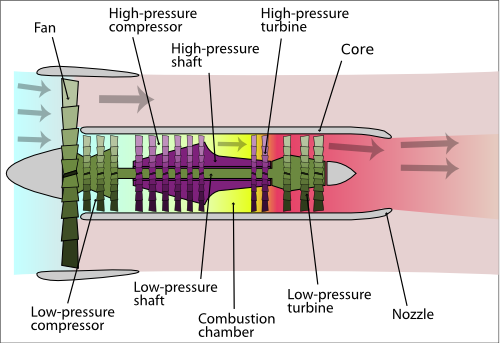Build a cheap turbofan
How to build a cheap (~ $150) turbofan?
Turbofan advantages over other propelling ways is that they provide enough trust to climb at high altitude, possibly at attractive speed, and that they are not much fuel-greedy and thus can be running for some time with limited extra-weight.
It however has the big disadvantage to be very complicated to manufacture as well as very expensive. On this page, we will explore how costs can be reduced, which will be the key for decision to use turbofans or not. They will have to be build in some way, because it will have to be tailored to our needs, which are quite unusual.
General principles
Lots of information are available on wikipedia's page. General principe is that there is a combustion that feeds a turbine, which drives the fan and the compression stage. The fan provides thrust from creating air pressure, and the combustion create thrust by evacuating hot gas. As air is compressed from the intake, more air becomes available for combustion, and thus create more work on the turbine, and more intake.
There are some design properties and configurations that have to be properly calculated depending on the use of the engine, mainly for the intended aircraft speed:
- The Bypass ratio (BPR) is a ratio between the mass flow rate of air drawn in by the fan but bypassing the engine core to the mass flow rate passing through the engine core. A BPR = 0 would be a turbojet engine. The higher BPR, the more efficient the engine, but also the slower exhaust speed.
- The number of spools: it is often seen that a second concentric shaft for high pressure operations drives the low pressure shaft on which is mounted the fan. One stage engines exist and are less complicated and expensive to build, but are also less efficient. A gearbox may be needed to drive the fan if the low pressure shaft is still to fast.
- The compression ratio is determined by the number of stages in the compressor and its efficiency. More compression mean more air to blend with fuel, and even more pressure at output, increasing the speed and mass of output gas, and thus overall engine efficiency.
Turbojet/turbofan engine simulation software from NASA: EngineSim
A good book by Klaus Hünecke: Jet engines: fundamentals of theory, design, and operation
Design versus manufacturing
Design configurations and properties taken into concern on real engines tend to increase efficiency, meaning higher thrusts for lower fuel consumption, but also try to reduce the exhaust noise. Cost is of course a concern, and an efficiency by itself, but not a constraint as important as it is for us.
Shaped core or shaped shaft?
I think that the main thing that can be optimized to reduce cost and complexity is the design of gas volumes in the turbine. In the above schema, we see that the shaft is straight and that the core envelope is curved to reduce volume on the high compression stage. In practice, the shaft has a bumped profile (small-large-small diameter), to help reduce the volume:
Compressor and turbine blades
The most complicated part to build in a turbofan or turbojet engine is the turbine and compression blades. The high-pressure turbine specially have to face very high temperature and pressure. On real engines, they are made of nickel-based superalloys.
The compressor is not only made of blades on the rotor, but also on the stator. Without those latter, the air flow would be turning inside the engine, driven by the rotation of the compressor. They allow to redirect the airflow on the next compression stage in the more appropriate and efficient direction.
What is the most simple yet efficient shape for turbine, compressor and fan blades? Are a flat shape and a continuous angle acceptable? Overlapping or not overlapping blades? Should they be build in a single piece of metal along with the axis mount ring or assembled from blades on mounting rings?
For better efficiency, very small gaps should exist between blades and the stator or the rotor for static blades. As always, good efficiency means good precision and higher cost. Anyway, the precision of blades will have to be very good if we don't want it to dislocate when it reaches the high rotation-per-minutes achieved by those engines.
Our design
Cooling might be needed if low cost metals are used. Expected combustion chamber temperature is around 2000°C for hydrocarbon or alcohol fuels. Iron melting point is around 1500°C...
Startup can be done at ground manually (with compressed air for example).
Engine must be designed with sensors, at least to determine if the engine is running properly or if it's under failure. Engine temperature should be used too.
External hardware
Fuel tanks in the wings, fuel pumps, fuel lines, and engine mounting will have to be considered if turbofans are used.

